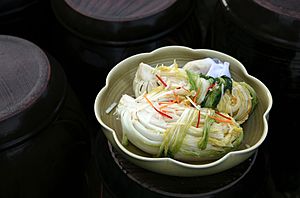Baek-kimchi facts for kids
 |
|
| Alternative names | White kimchi |
|---|---|
| Type | Kimchi |
| Place of origin | Korea |
| Main ingredients | Napa cabbage |
| Korean name | |
| Hangul |
백김치
|
|---|---|
| Hanja |
白김치
|
| Revised Romanization | baek-gimchi |
| McCune–Reischauer | paek-kimch'i |
| IPA | [pɛ̝k̚.k͈im.tɕʰi] |
Baek-kimchi (백김치), also called white kimchi, is a special kind of kimchi. Unlike most kimchi, it doesn't use spicy chili pepper powder. This makes it taste mild and fresh.
Because it's not spicy, baek-kimchi is a great choice for kids and older people. Regular kimchi can sometimes be too hot for them. Baek-kimchi is made with salted napa cabbage, radish, and other yummy ingredients. These include minari, spring onions, Korean pear, chestnuts, jujube, ginger, and garlic. It also has a little salt and sugar. Sometimes, a few chili threads are added just for decoration.
Baek-kimchi has a gentle flavor and a nice crunch. This makes it a perfect starter, or appetizer, at Korean restaurants. People often eat it before main dishes like galbi or bulgogi, which are types of beef. It can also be used as a wrap for a dish called baek kimchi bossam.
Contents
Amazing Health Benefits of Baek-kimchi
Baek-kimchi is not just tasty; it's super good for you! It's packed with helpful things like vitamin C, minerals, and special "good" bacteria. It also has lots of fiber. Eating baek-kimchi can help keep your body healthy and strong.
How Baek-kimchi Helps Your Tummy
Fermented foods like baek-kimchi have "good" bacteria. These bacteria are called lactic acid bacteria. They help your body use nutrients better. They can also help your digestive system work smoothly. This means they can make your tummy feel much better.
If you have tummy troubles, the lactic acid bacteria in baek-kimchi can help. It can calm down problems like irritable bowel syndrome. Because baek-kimchi isn't spicy, it's gentle on your stomach. It helps reduce swelling that can cause tummy pain. These "good" gut bacteria can even help prevent ulcers. A healthy gut can also help your brain work better, as your nervous system connects everything in your body!
Baek-kimchi for a Healthy Body
Baek-kimchi can also help lower cholesterol. Cholesterol is a type of fat in your blood. Too much can be bad for your heart. Studies have shown that people who ate fermented baek-kimchi had lower cholesterol levels.
It can also help with weight loss. In one study, people who were overweight and ate fermented kimchi lost body fat. Baek-kimchi helped them keep healthy fats while losing weight. It also lowered their risk of heart problems.
Vitamins and More Good Stuff
Baek-kimchi has many important vitamins. For example, it contains vitamin A, which is great for your eyes. The "good" bacteria and other helpful things in baek-kimchi can also help your body fight off infections. They give your immune system a boost!
This amazing food also has special substances like isocyanate and sulfides. These can help your organs clean out bad stuff, like heavy metals. This helps protect you from serious illnesses. Eating baek-kimchi regularly can also lead to healthy hair and skin. This can even make you feel better about yourself! Some people also find that baek-kimchi gives them more energy.
Nutritional Facts
Baek-kimchi is low in calories. It's also high in iron and protein. A single serving, which is about one cup, has only about 23 calories. It gives you 2 grams of protein and less than 1 gram of fat. You also get 4 grams of carbohydrates, 2 grams of sugar, and 2 grams of fiber. It provides 747 milligrams of sodium. Plus, one serving gives you about 21% of the iron you need each day!
See also
 In Spanish: Baek kimchi para niños
In Spanish: Baek kimchi para niños

